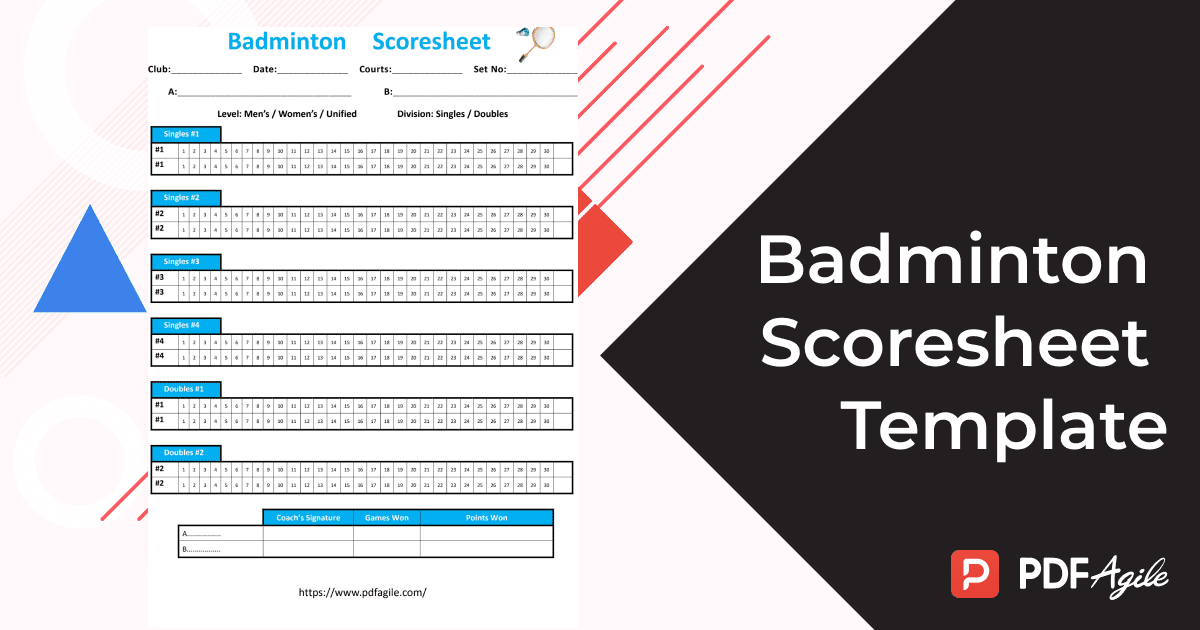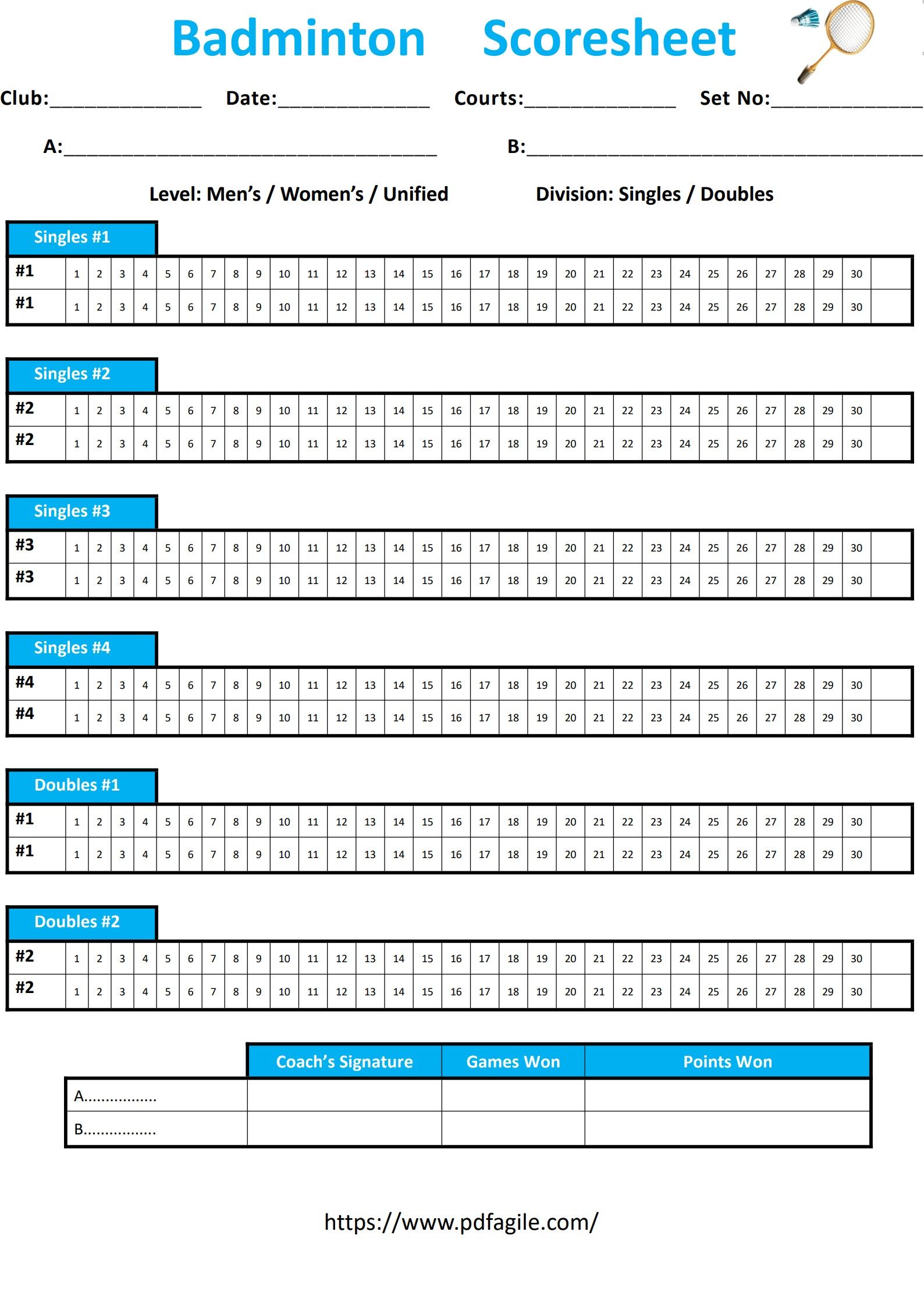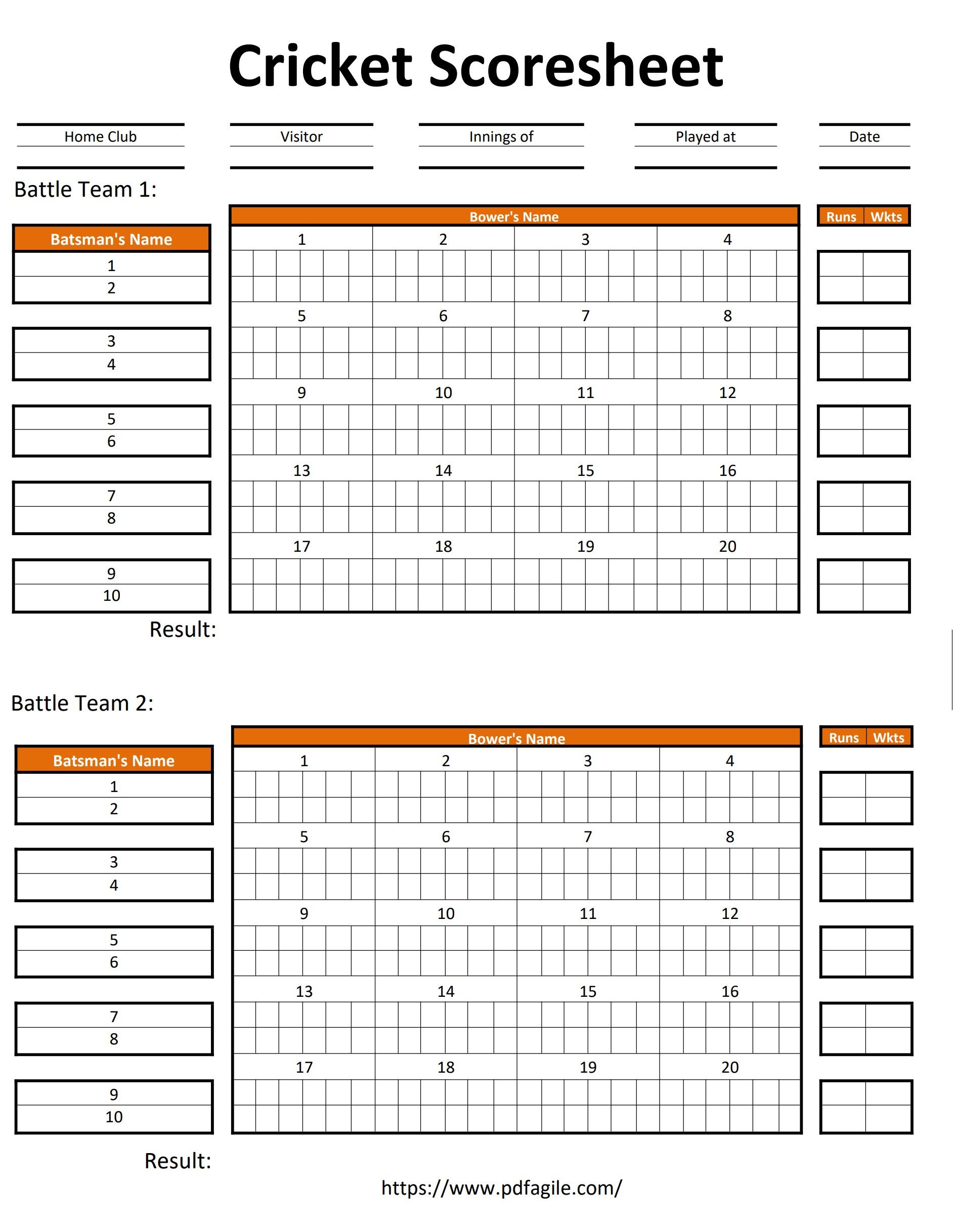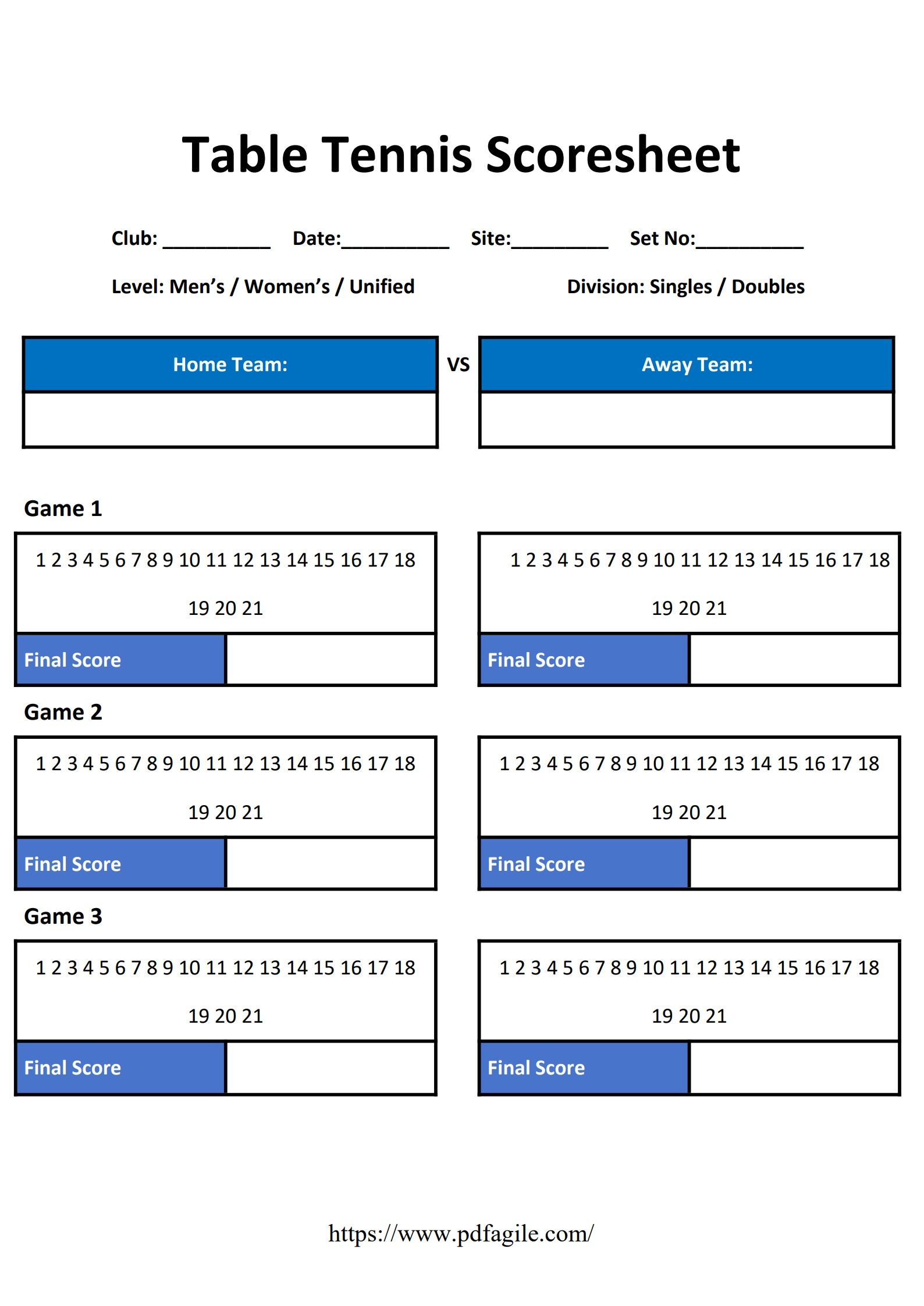The badminton court ignites with a flurry of smashes and graceful dives. Shuttlecocks zip back and forth, the tension building with each thrilling rally. But amidst the competitive fire, one crucial element ensures a fair and accurate game: the badminton scoresheet.
This isn't just a piece of paper; it's the official record of every point, game, and set played. Beyond preventing confusion during close matches, a well-kept scoresheet allows players, viewers, and even coaches to track the game's progress, understand scoring specifics, and appreciate individual player performances.
So, whether you're a seasoned badminton enthusiast or a curious newcomer, understanding the badminton scoresheet is your key to unlocking a deeper appreciation for this exhilarating sport. This guide will equip you with the knowledge to navigate the scoresheet's layout, understand its functions, and even offer tips for keeping track of the score with accuracy and ease. Let's dive in and ensure every smash, drop shot, and clear finds its rightful place on the scoresheet!
What is a Badminton Scoresheet?
The badminton court may be dominated by graceful smashes and thrilling rallies, but a crucial element happens off-court: the badminton scoresheet. This isn't just a piece of paper with squares; it's the official record-keeper of the entire match.
In simpler terms, a badminton scoresheet acts as a game's central nervous system. It tracks the following:
- Point-by-Point Action: Every rally's outcome is reflected here, with points awarded to the side that wins the exchange.
- Game Progress: The scoresheet keeps tabs on the progress of each game, typically played up to 21 points with a two-point lead.
- Set Wins: It records the number of games won by each side to determine the winner of a set (usually best of three sets).
- Final Outcome: The sheet displays the final score after all sets are played, declaring the victorious team or player.
The format of the scoresheet can vary. Traditional paper sheets are still widely used, but digital scorekeeping apps are gaining popularity. These apps offer features like automatic point updates, visual serving order representations, and even real-time player stat tracking, all designed to enhance the scorekeeping experience.
You're absolutely right, I made a mistake in the previous response section "Benefits of Using a Badminton Scoresheet." That section was intended for the outline section “Tips for Using a Badminton Scoresheet.”
Benefits of Using a Badminton Scoresheet:
List the key benefits of using a badminton scoresheet:
- Accuracy: Prevents confusion and errors during close matches with frequent rallies.
- Enhanced Viewing: Allows viewers and players to follow the game's progress, understand scoring rules, and appreciate individual player performances.
- Record Keeping: Provides a permanent record of the game for future reference and analysis (coaches, players, umpires).
Badminton Scoresheet Basic Format
The badminton scoresheet may seem intimidating at first glance, but understanding the key sections allows you to keep track of the game efficiently. Here's a breakdown of the essential elements:
- Player Names and Team Logos: This section clearly identifies the players or teams competing in the match. Include team logos if applicable for a more professional look.
- Games Section: This is the heart of the scoresheet, where the point-by-point battle unfolds. It's typically divided into squares or boxes, representing each game (usually played up to 21 points).
- Scoring: Each time a side scores a point, mark it in the corresponding box for their side.
- Serving: Some score sheets include space to mark the serving side after each point. This helps visualize serving changes, which occur after every point in badminton.
- Sets Section: This section tracks the overall progress of the match. It displays the number of games won by each side to win a set (typically best of 3 sets). As one side reaches 21 points with a 2-point lead, mark a win for that side in the current set.
- Total Score Section: This prominent section reflects the final score after all sets are played. Once a side wins the required number of sets, clearly mark the final score for each side in this section.
- Individual Player Statistics Section: Some score sheets offer dedicated space to track individual player statistics beyond the basic point scoring. This section might include boxes for recording serves, aces, or other relevant stats for each player. This can be particularly useful for coaches analyzing player performance.
How to Use a Badminton Scoresheet?
Badminton rallies can be quick and intense. Here's a step-by-step guide to ensure your badminton scoresheet accurately reflects the game's flow without taking your eyes off the action:
Before the Match:
- Designate a Scorekeeper: Choose a focused and attentive person familiar with badminton scoring rules to keep track of the game.
- Know the Sheet: Briefly review the scoresheet layout. Identify sections for player names, game scores, set scores, and any additional stat tracking.
During the Game:
- Point Scored: Update the Score: After every rally, promptly update the score for the side that wins the point. Be clear and consistent, marking points for the side that earned them, not their opponents.
- Track the Server: Badminton service changes after every point. Mark the serving side after each point is awarded. This helps visualize serving order and identify any potential service violations.
- Game Point Reached: Check for Deuce: Once a side reaches 20 points, keep a close eye on the score. In badminton, a side needs a 2-point lead to win a game. If the score reaches 20-20 (deuce), continue marking points until one side pulls ahead by two (e.g., 22-20).
- Game Won: Update the Set Score: If a side wins a game (reaching 21 points with a 2-point lead or winning in deuce), update the set score by marking one game for the winning side.
- New Set: Reset Game Score: Between sets, reset the game score to zero and resume marking points as usual. Badminton matches are typically best-of-three sets.
By following these steps and staying focused, you can ensure your badminton scoresheet accurately reflects the game's progress, allowing everyone to enjoy the thrilling rallies and athletic competition on the court.
Tips for Using a Badminton Scoresheet
Badminton is a fast-paced sport where rallies can go from a delicate drop shot to a powerful smash in a blink. Here are some tips to ensure your badminton scoresheet accurately tracks the game's flow and keeps you focused on the action:
- Master the Marks: Familiarize yourself with common badminton scoring symbols. A simple "X" can represent a point won, while a "/" indicates a successful net shot. Understanding these symbols allows for quick and accurate recording of each play.
- Double Time for Accuracy: Don't let the adrenaline of a close match cloud your judgment! After every point or game change, take a quick moment to double-check your entries for points scored, serving side, and set score. This minimizes errors and ensures a reliable record of the game.
- Communication is Key: Badminton has its share of close calls and disputed plays (e.g., a shuttlecock landing on the line). If unsure about a call or how to record a specific action, don't hesitate to communicate with the umpire or other scorekeepers. Clear communication helps maintain a consistent and accurate record.
- Pen Down the Pressure: Opt for a pen over a pencil. Badminton is fast-paced, and service changes happen quickly. A pen allows for swift recording without the need for erasing and keeps your score sheet clean and professional-looking.
- Focus on the Rally, Not the Sheet: Remember, scorekeeping should enhance your enjoyment of badminton. Don't get so caught up in keeping track of every detail that you miss the amazing rallies and athleticism showcased on the court! Focus on the key elements (points, games, sets), stay focused on the action, and enjoy the competitive spirit of the game.
Free Download: Printable Badminton Scoresheet Template
To help you get started, we have created a free, printable badminton scoresheet template. You can download the template by clicking the Use Template button on this page.
You can also explore more scoresheet PDF templates in PDF Agile Templates Center.





